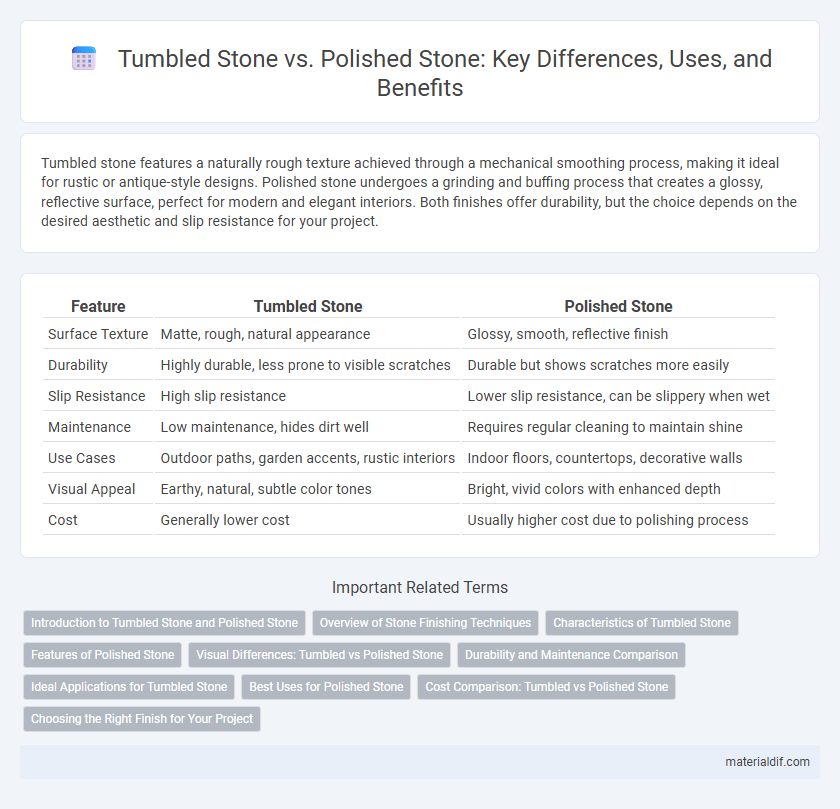Tumbled stone features a naturally rough texture achieved through a mechanical smoothing process, making it ideal for rustic or antique-style designs. Polished stone undergoes a grinding and buffing process that creates a glossy, reflective surface, perfect for modern and elegant interiors. Both finishes offer durability, but the choice depends on the desired aesthetic and slip resistance for your project.
Table of Comparison
| Feature | Tumbled Stone | Polished Stone |
|---|---|---|
| Surface Texture | Matte, rough, natural appearance | Glossy, smooth, reflective finish |
| Durability | Highly durable, less prone to visible scratches | Durable but shows scratches more easily |
| Slip Resistance | High slip resistance | Lower slip resistance, can be slippery when wet |
| Maintenance | Low maintenance, hides dirt well | Requires regular cleaning to maintain shine |
| Use Cases | Outdoor paths, garden accents, rustic interiors | Indoor floors, countertops, decorative walls |
| Visual Appeal | Earthy, natural, subtle color tones | Bright, vivid colors with enhanced depth |
| Cost | Generally lower cost | Usually higher cost due to polishing process |
Introduction to Tumbled Stone and Polished Stone
Tumbled stone features a naturally weathered, matte finish achieved by placing rough stones in a rotating drum with abrasives, resulting in rounded edges and a rustic appearance ideal for landscaping and decorative uses. Polished stone undergoes a grinding and buffing process to create a smooth, reflective surface that enhances color and pattern, commonly used in countertops, flooring, and wall cladding. Both finishes showcase the unique characteristics of natural stones like granite, marble, and limestone but serve different aesthetic and functional purposes based on texture and shine.
Overview of Stone Finishing Techniques
Tumbled stone features a rustic, weathered appearance achieved through tumbling and abrasion, resulting in a matte, textured surface ideal for outdoor applications and vintage aesthetics. Polished stone undergoes a grinding and buffing process to produce a smooth, glossy finish that enhances color vibrancy and depth, commonly used in interior flooring and countertops. Both finishing techniques influence durability, slip resistance, and visual appeal, making them suitable for different architectural and design preferences.
Characteristics of Tumbled Stone
Tumbled stone features a naturally rustic texture, created by mechanically tumbling rough stones to soften edges and produce a matte, weathered appearance. Its porous surface enhances grip and makes it ideal for outdoor pathways, garden beds, and decorative accents where slip-resistance is crucial. The irregular shapes and subtle color variations of tumbled stone offer a timeless, organic aesthetic distinct from the smooth, reflective finish of polished stone.
Features of Polished Stone
Polished stone features a smooth, reflective surface achieved through grinding and buffing, enhancing its natural color and pattern depth. Its glossy finish increases resistance to staining and water absorption, making it ideal for countertops and indoor flooring. Polished stone also demands regular maintenance to preserve its shine and prevent surface scratches.
Visual Differences: Tumbled vs Polished Stone
Tumbled stone features a weathered, matte finish with rounded edges, creating a rustic and natural appearance, while polished stone offers a smooth, glossy surface that enhances color depth and reflects light vividly. The visual texture of tumbled stone reveals soft variations and subtle imperfections, contrasting sharply with the sleek, uniform look of polished stone. This distinction makes tumbled stone ideal for casual, organic designs, whereas polished stone suits elegant, contemporary aesthetics.
Durability and Maintenance Comparison
Tumbled stone features a naturally weathered, textured surface that offers enhanced slip resistance but can be more prone to surface wear and staining over time, requiring regular sealing for durability. Polished stone provides a sleek, glossy finish that highlights the stone's color and pattern, yet it is more susceptible to scratches and etching, demanding gentle cleaning and more frequent maintenance to preserve its shine. Both types need appropriate care tailored to their finish to maintain longevity and appearance in high-traffic or outdoor applications.
Ideal Applications for Tumbled Stone
Tumbled stone, characterized by its rough texture and aged appearance, is ideal for outdoor landscaping, garden pathways, and decorative walls where natural slip resistance and rustic charm are essential. Its weathered finish enhances areas exposed to heavy foot traffic and outdoor elements, providing both durability and aesthetic appeal. This makes tumbled stone a preferred choice for patios, walkways, and fireplace surrounds in rustic or Mediterranean-style designs.
Best Uses for Polished Stone
Polished stone features a smooth, glossy surface that enhances natural colors and patterns, making it ideal for indoor applications such as countertops, flooring, and wall cladding in residential and commercial spaces. Its reflective finish is best suited for areas where aesthetic appeal and easy cleaning are priorities, including bathrooms and kitchens. Despite its beauty, polished stone is less slip-resistant, so it is less appropriate for outdoor walkways and high-traffic exterior areas.
Cost Comparison: Tumbled vs Polished Stone
Tumbled stone generally costs less than polished stone due to its simpler finishing process, which involves tumbling rough stone to create a weathered, natural look. Polished stone requires more labor and advanced equipment to achieve its smooth, glossy surface, increasing production costs significantly. The price difference often influences project budgets, with tumbled stone favored for cost-conscious designs and polished stone selected for upscale, high-end appearances.
Choosing the Right Finish for Your Project
Tumbled stone offers a weathered, natural look with a textured surface that enhances grip and is ideal for rustic or outdoor projects, while polished stone provides a sleek, glossy finish suited for modern interiors requiring elegance and easy maintenance. Selecting the right finish depends on project requirements such as aesthetic preference, slip resistance, and durability; tumbled stone excels in high-traffic or wet areas, whereas polished stone is best for formal, low-moisture environments. Evaluating factors like foot traffic, exposure to elements, and desired visual impact ensures the finish complements both functionality and design goals.
Tumbled Stone vs Polished Stone Infographic

 materialdif.com
materialdif.com